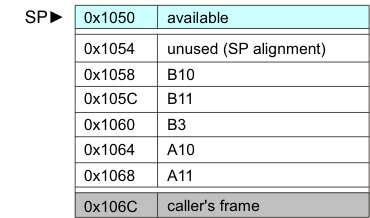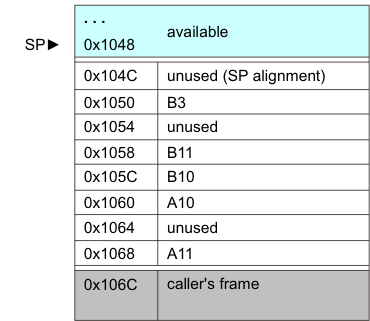SPRAB89A September 2011 – March 2014
- 1 Introduction
- 2 Data Representation
- 3 Calling Conventions
- 4 Data Allocation and Addressing
- 5 Code Allocation and Addressing
- 6 Addressing Model for Dynamic Linking
-
7 Thread-Local Storage Allocation and Addressing
- 7.1 About Multi-Threading and Thread-Local Storage
- 7.2 Terms and Concepts
- 7.3 User Interface
- 7.4 ELF Object File Representation
- 7.5
TLS Access Models
- 7.5.1 C6x Linux TLS Models
- 7.5.2 Static Executable TLS Model
- 7.5.3 Bare-Metal Dynamic Linking TLS Model
- 7.6 Thread-Local Symbol Resolution and Weak References
- 8 Helper Function API
-
9 Standard C Library API
- 9.1 Reserved Symbols
- 9.2 <assert.h> Implementation
- 9.3 <complex.h> Implementation
- 9.4 <ctype.h> Implementation
- 9.5 <errno.h> Implementation
- 9.6 <float.h> Implementation
- 9.7 <inttypes.h> Implementation
- 9.8 <iso646.h> Implementation
- 9.9 <limits.h> Implementation
- 9.10 <locale.h> Implementation
- 9.11 <math.h> Implementation
- 9.12 <setjmp.h> Implementation
- 9.13 <signal.h> Implementation
- 9.14 <stdarg.h> Implementation
- 9.15 <stdbool.h> Implementation
- 9.16 <stddef.h> Implementation
- 9.17 <stdint.h> Implementation
- 9.18 <stdio.h> Implementation
- 9.19 <stdlib.h> Implementation
- 9.20 <string.h> Implementation
- 9.21 <tgmath.h> Implementation
- 9.22 <time.h> Implementation
- 9.23 <wchar.h> Implementation
- 9.24 <wctype.h> Implementation
-
10C++ ABI
- 10.1 Limits (GC++ABI 1.2)
- 10.2 Export Template (GC++ABI 1.4.2)
- 10.3 Data Layout (GC++ABI Chapter 2)
- 10.4 Initialization Guard Variables (GC++ABI 2.8)
- 10.5 Constructor Return Value (GC++ABI 3.1.5)
- 10.6 One-Time Construction API (GC++ABI 3.3.2)
- 10.7 Controlling Object Construction Order (GC++ ABI 3.3.4)
- 10.8 Demangler API (GC++ABI 3.4)
- 10.9 Static Data (GC++ ABI 5.2.2)
- 10.10 Virtual Tables and the Key function (GC++ABI 5.2.3)
- 10.11 Unwind Table Location (GC++ABI 5.3)
-
11Exception Handling
- 11.1 Overview
- 11.2 PREL31 Encoding
- 11.3 The Exception Index Table (EXIDX)
- 11.4 The Exception Handling Instruction Table (EXTAB)
- 11.5 Unwinding Instructions
- 11.6 Descriptors
- 11.7 Special Sections
- 11.8 Interaction With Non-C++ Code
- 11.9 Interaction With System Features
- 11.10 Assembly Language Operators in the TI Toolchain
- 12DWARF
- 13ELF Object Files (Processor Supplement)
- 14ELF Program Loading and Dynamic Linking (Processor Supplement)
-
15Linux ABI
- 15.1 File Types
- 15.2 ELF Identification
- 15.3 Program Headers and Segments
- 15.4 Data Addressing
- 15.5 Code Addressing
- 15.6 Lazy Binding
- 15.7 Visibility
- 15.8 Preemption
- 15.9 Import-as-Own Preemption
- 15.10 Program Loading
- 15.11 Dynamic Information
- 15.12 Initialization and Termination Functions
- 15.13 Summary of the Linux Model
- 16Symbol Versioning
- 17Build Attributes
- 18Copy Tables and Variable Initialization
- 19Extended Program Header Attributes
- 20Revision History
4.4.4.2 Compact Frame Layout
In order to encourage the use of compressible instructions, the register save/restore code is slightly different for some C64x+ functions.
Ordinarily, the compiler allocates the entire frame with one SP decrement and then saves the callee-saved registers with SP-relative writes.
STW B14, *SP--[12]
STDW A15:A14, *SP[5]
STDW A13:A12, *SP[4]
STDW A11:A10, *SP[3]
STDW B13:B12, *SP[2]
STDW B11:B10, *SP[1]In compact frame mode, the compiler instead generates a series of SP-auto-decrementing stores for each register pair.
STW B14, *SP--[2]
STDW A15:A14, *SP--
STDW A13:A12, *SP--
STDW A11:A10, *SP--
STDW B13:B12, *SP--
STDW B11:B10, *SP--For this case, the stack layout is the same. However, the stack layout can be different for different saved register subsets. For instance, suppose we need to save A10, A11, B10, B11, and B3, and we choose to use the compact frame layout to save code size. The traditional layout will make the most efficient use of stack space:
STW A11, *SP--[6]
STW A10, *+SP[5]
STW B3, *+SP[4]
STW B11, *+SP[3]
STW B10, *+SP[2]
However, the compact frame layout will leave multiple holes in the register save area in order to use more compressible SP decrement instructions. Since every push must decrement SP by 8 (for interrupt safety), the compiler tries to push members of register pairs together; if it cannot, it must push a single register into a double word, making a hole in the save area.
STW A11, *SP--[2]
STW A10, *SP--[2]
STDW B11:B10, *SP--
STW B3, *SP--[2]